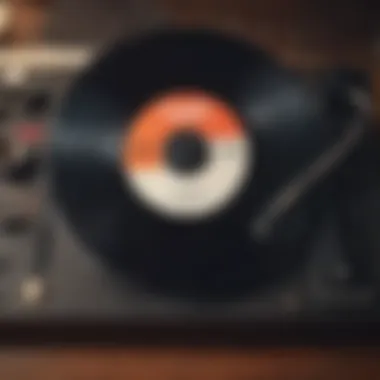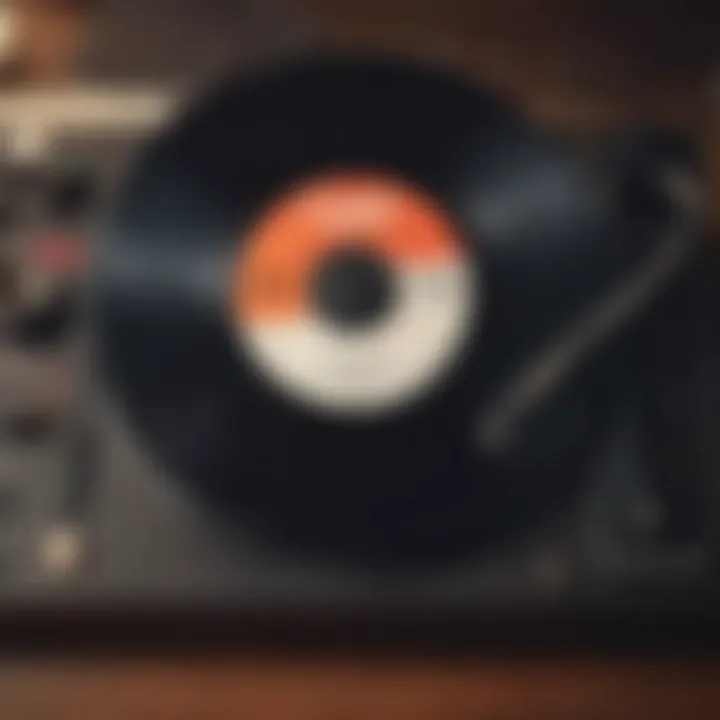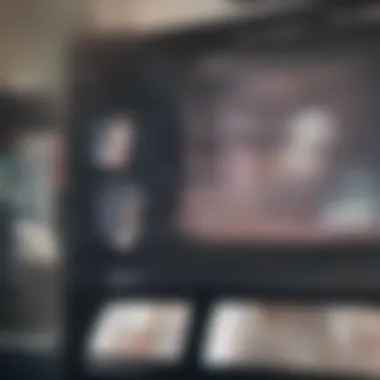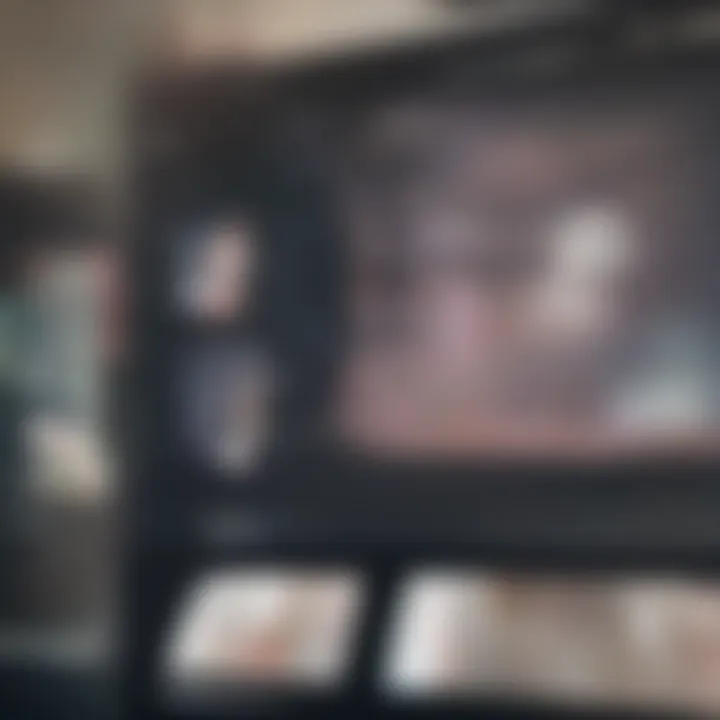The Pursuit of Music: Ethical Choices in Acquisition


Intro
The quest for music reveals various journeys that individuals take to engage with their favorite sounds. Acquisition methods have evolved significantly over time, shaping how both creators and listeners experience music. This exploration scrutinizes these paths—be it purchasing, borrowing, or even more contentious means—while considering the ethical and cultural implications intertwined within the music industry.
Understanding how music can be acquired involves looking at socio-economic factors, technological advancements, and the relentless push against copyright disputes. Each of these aspects contributes to defining how music is valued and accessed, hence affecting the sustainability of artists.
By dissecting the nuances involved in acquiring music, we aspire to shed light on not just the transactions that occur but also their deeper meanings. How does borrowing from friends shape one’s exposure to new genres? What impact does purchasing digital versus physical formats have on our relationship with artists? These questions are vital when pondering the nature of music appreciation in today’s society.
Artist Profile
Biography and Background
When examining music acquisition, understanding the artist's perspective is essential. Their stories often reflect a broader narrative about the music industry’s structure and its challenges. For instance, established artists like Taylor Swift have faced significant issues regarding music ownership and streaming rights. Swift’s fight against major labels to regain control of her work is a prime example of how the evolution of music consumption affects not just fans, but the very creators behind the art.
Major Influences and Inspirations
Artists draw inspiration from varied sources, including societal contexts, personal experiences, and other musicians. Consider how Nirvana’s Kurt Cobain was influenced by punk rock and the Seattle music scene. His raw expression resonated with a generation, both through its authenticity and as a response to the commercialized music environment. This interplay of inspiration and individual expression reveals how cultural shifts can directly inform and influence an artist's work.
Song Analysis
Theme and Lyrics Breakdown
Delving into specific songs can provide insight into how thematic elements reflect personal or societal narratives. For example, Billie Eilish's work frequently tackles themes of mental health and identity. This lyrical depth offers listeners more than just entertainment; it encourages reflection and discussion around pressing issues faced by many in contemporary society.
Instrumentation and Composition
Instrumentation also plays a vital role in music acquisition discussions. The evolution from classic instruments to digital production showcases how technology has altered music's landscape. The minimalist approach in Eilish's music, utilizing silent breaks and unconventional sounds, highlights that composition extends beyond mere notes—it’s about the emotions and thoughts the music evokes. Understanding these elements can enhance the appreciation of music and inform listeners’ choices in acquisition.
"The way we access music today necessitates a reflection on the practices we support, as they ultimately shape the musical landscape of tomorrow."
Implications of Music Acquisition
The methods of acquiring music carry multifaceted implications for both artists and listeners. Ethical considerations arise when discussing illegal downloads or unauthorized streaming, leading to a debate on fair compensation for artists. Moreover, the act of borrowing music, whether through sharing via platforms like Facebook or through playlists on Reddit, has transformed how we experience musical diversity. It fosters a communal environment, yet it can also lead to questions of authenticity and credit.
In summarizing discussions around music acquisition, the relationship between artist and listener emerges as crucial. It shapes how we consume music and ultimately dictates the health of the music industry itself.
An exploration of the dynamics behind music acquisition not only educates but also empowers individuals to make conscious decisions that benefit artists, culture, and their own musical journeys.
Prolusion to Music Acquisition
Understanding how music is acquired is essential for grasping its role in society today. Music acquisition involves a diverse range of methods, each with unique implications for both listeners and artists. As we delve into this topic, it becomes clear that approaches to acquiring music reflect broader cultural and ethical considerations. They reveal not only the personal preferences of listeners but also the systems that sustain the music industry.
By analyzing the various ways in which music can be obtained, we begin to appreciate the complexities surrounding ownership and artistic creation. This exploration extends beyond mere economics; it includes emotional and social dimensions as well. Music can serve as a connector between individuals, impacting community dynamics and personal interactions. Consequently, how we acquire music can shape our engagement with it, potentially enhancing or diminishing its perceived value.
Moreover, advancements in technology have transformed the landscape of music acquisition in significant ways. Digital platforms have democratized access to music, allowing for unprecedented levels of enjoyment and sharing. However, these advancements also introduce ethical dilemmas regarding copyright and artist compensation.
In summary, understanding music acquisition sets the foundation for deeper discussions on its cultural implications, the ethics involved, and how it shapes the future of music ownership.
Understanding the Concept of Acquisition
The concept of acquisition in music encompasses various methods through which individuals can access music. These methods range from legitimate purchases to informal borrowing or more controversial practices like piracy. Each method carries different ethical implications and societal impacts.
In today's digital landscape, acquisition is not just a matter of simply buying records or downloading songs. Instead, it often involves streaming, sharing playlists, and engaging with content online. Asking oneself, "What does it mean to own music?" is a fundamental question in this realm.
Various platforms, such as Spotify and Apple Music, highlight the shift from ownership to access, reshaping how we think about musical consumption. Listeners can now access vast libraries of music at their fingertips, changing the way music is appreciated and consumed.
Historical Perspectives on Music Access
Historical perspectives on music access illustrate the evolution of how music has been shared and consumed over the centuries. In the past, live performances and physical formats such as vinyl records and cassette tapes dominated music distribution. The necessity for live events meant that access to music was limited by geographical constraints.
As mediums evolved, so did accessibility. The introduction of radio and later television opened new avenues for music exposure. The ability to hear music without needing to own a physical copy allowed it to permeate social spaces in ways previously unachievable.
The advent of the internet dramatically changed this landscape, giving rise to ongoing debates about access, ownership, and legalities surrounding music distribution. With platforms such as Napster emerging in the late 1990s, the paradigm shifted again, raising questions about copyright that remain relevant today.
The Dynamics of Begging for Music
Begging for music presents a unique and often nuanced dynamic within the music community. This section will explore how the act of appealing for music or musical resources shapes relationships among fans, artists, and the cultural landscape at large. The essence of this dynamic lies in mutual support where listeners often rely on each other for access to music, fostering a sense of community. Understanding why people beg for music can provide insights into the importance of social bonds that influence musical preferences and consumption.
The Nature of Seeking Favor in Music Communities
Music communities, whether online or offline, have developed intricate networks of support among users. Seeking favor within these groups reflects a deeper desire for connection and belonging. Fans often appeal to one another for recommendations or direct access to specific music. This communal approach has gained traction particularly in spaces such as forums or social media platforms. A few notable characteristics include:
- Social Interactions: Engaging in discussions about a favored artist or sharing music creates a communal atmosphere.
- Reciprocity: Members are likely to provide music in return for past favors, reinforcing bonds.
- Accessibility: The idea that music should be shared freely fosters an egalitarian culture.


As such, begging for music can also be seen as a reflection of cultural values that prioritize accessibility over ownership. This can create ethical dilemmas regarding the sustainability of artists’ livelihoods, highlighting the dual nature of communication in music sharing.
Crowdsourcing as a Modern Phenomenon
Crowdsourcing embodies a significant change in how individuals obtain music. With the rise of digital platforms, listeners can now turn to their networks to solicit music, whether by asking for streaming links or sharing playlists. This modern approach serves two main functions:
- Democratization of Music Access: Individuals have broader access to music without relying solely on traditional purchase models.
- Community Involvement: Groups collaborate to curate tracks, fostering an actively engaged audience.
This trend reflects the transformation in music distribution, where artists and listeners alike navigate the complexities of ownership. Digital platforms and social networks facilitate this interaction, blending the lines of music sharing, borrowing, and ethical considerations concerning copyright.
The Ethics of Stealing Music
Understanding the ethics of stealing music is crucial for grasping the complexities surrounding music acquisition today. In an era where accessibility to music is easier than ever, the moral considerations around obtaining music are under scrutiny. This topic raises important questions regarding artist rights, cultural value, and the impact of pirated content on the creative ecosystem. Addressing these dimensions can help clarify the responsibilities of listeners and the implications of their choices on the broader industry.
Defining Music Theft in the Digital Era
In the digital age, music theft encompasses various forms of unauthorized distribution and reproduction. Traditional definitions of music theft involved physical copies, but the landscape has evolved significantly. Nowadays, piracy is mainly seen through illegal downloads, file-sharing sites, and unauthorized streaming.
The issue is not merely one of legality; it extends to ethics. Many users justify downloading music without payment by arguing they are merely sampling or that the artist already makes enough money. However, this perspective often overlooks the labor and investment artists put into their work. When someone distributes or consumes music without compensating the creator, it diminishes the value of the work and, over time, can erode the financial foundation that supports the artist.
The Consequences of Piracy on Artists
The effects of music piracy on artists are multi-faceted and often detrimental. Artists depend on various revenue streams such as album sales, merchandise, and concerts. When pirated content circulates freely, it undermines their legal income sources. Here are some major consequences of piracy on artists:
- Loss of Revenue: Artists can face significant financial losses when their music is illegally shared. Each unlicensed download signifies a potential sale lost.
- Devaluation of Work: When music is obtained for free, it may imply that the work holds lesser value. This perception can harm an artist's reputation and limit their marketability.
- Inequitable Compensation Models: Artists often struggle with platforms like Spotify that operate on slim profit margins. When piracy reduces their perceived worth, it can lead to a system that favors only the most commercially viable artists, leaving indie musicians and lesser-known acts in precarious positions.
- Impact on Future Projects: Financial strain from piracy can restrict artists in their capacity to produce new music. Without adequate support, they may have to reassess their projects, leading to fewer diverse voices in the industry.
"Music piracy does not only steal from artists; it steals from culture. When we support piracy, we support a vision of a world where creativity loses its value, and artists are unable to sustain their craft."
The Concept of Borrowing Music
The act of borrowing music embodies a rich tradition within various cultures and contexts. It is not simply a matter of taking something temporarily; it implies a deeper engagement with the music itself and the artist behind it. Borrowing can often be seen as a way to experience music without the immediate constraints of purchase or ownership. This concept also leads us into a broader discourse about access, community, and the shared nature of artistic expression.
Understanding the importance of borrowing in music is essential for music enthusiasts, aspiring musicians, and students alike. Whether it is via informal sharing or more structured systems, such as lending libraries or digital platforms, borrowing opens pathways for exploration and discovery. It allows listeners to experience a wide array of genres and styles, promoting a diversity of influences which can benefit creators in formative stages of their work.
Benefits of Borrowing Music
- Access to Diverse Genres: Borrowing enables exposure to different music styles. This can enrich a listener’s experience and inform their personal taste.
- Encouragement of Community Engagement: Sharing music fosters connections among listeners. It builds a sense of community within music culture.
- Cost-Effective Learning: For students and aspiring musicians, borrowing can offer access to educational materials and recorded music that might be financially inaccessible.
- Facilitating Cultural Exchange: Borrowing allows music from various backgrounds to circulate within different cultural groups, leading to broader appreciation and understanding of global musical landscapes.
However, matters of ethics and respect towards the creative ownership of music must be woven into this dialogue about borrowing. It leads into discussions on how music culture identifies and treats borrowed works, which brings us to the next section.
Distinct Forms of Borrowing in Music Culture
Within the music world, borrowing takes on various forms, each with its own significance and implications. Understanding these distinct forms can illuminate how artists and audiences navigate the complex territory of musical ownership and sharing.
- Sampling: This involves taking snippets or excerpts from existing recordings to create new works. While popular in genres like hip-hop, this form of borrowing exists in a gray area of copyright.
- Cover Songs: When musicians cover existing songs, they borrow the composition to reinterpret it. This practice holds significant cultural value and fosters community across musical styles.
- Lending Libraries and Archives: Many communities maintain libraries where patrons can borrow music scores or recordings, promoting access to music education.
- Peer-to-Peer Sharing: In informal settings, sharing playlists or records among friends reflects an organic form of borrowing that fosters camaraderie.
Each of these forms illustrates different aspects of how music flows between creators and listeners, shaping the landscape of production and influence within the industry.
Impact of Streaming Services on Borrowing Practices
Streaming services have dramatically altered the methods and practices surrounding the borrowing of music in contemporary society. Platforms such as Spotify and Apple Music have shifted music consumption patterns, allowing access to extensive libraries without the need for purchase.
The implications of this shift are profound:
- Instant Access: Streaming provides instantaneous access to vast catalogs of music, removing barriers to exploration.
- Playlists as Borrowing Tools: Users share playlists, effectively borrowing and blending various genres and styles. This promotes a more fluid interaction with music.
- Revenue Models: Artists receive compensation through streaming royalties, yet the model continues to be debated, questioning its sustainability and fairness for creators.
In summary, the concept of borrowing music serves as a critical lens to examine the interactions between ownership, access, and community in music culture. As the landscape continues to evolve with technology, it is imperative to consider how these changes influence both listeners and artists, fostering dialogues about ethics and the future of music.
Cultural Implications of Music Acquisition Methods
The way music is acquired holds significant cultural implications that extends far beyond the individual listener. Music is not just a form of entertainment; it serves as a means of identity formation, social connection, and cultural exchange. In this context, the methods by which music is obtained—whether through purchasing, borrowing, or the appropriations often associated with various cultures—reflect broader social values and norms. This article will examine how these acquisition methods shape communal interactions and influence the music landscape itself.
Music as a Social Currency
Music functions as a social currency in many communities. People often exchange music to build relationships or reinforce social bonds. In informal settings, the act of sharing playlists, discussing artists, or recommending tracks can create deeper connections among individuals. This communal aspect can lead to new forms of collaboration among artists and listeners alike.
- Social Status: Certain music genres may grant individuals social status within a specific group. Owning rare records or being the first to discover a new artist allows one to gain respect and admiration.
- Cultural Sharing: Music sharing fosters cultural appreciation and understanding. By borrowing or lending music, individuals expose themselves and their social circles to different cultures and backgrounds. Bridging gaps through shared musical experiences can promote deeper intercultural dialogues.
- Inclusivity and Exclusivity: The availability of music as a social currency varies among different demographic groups. Economic status, technological access, and geographical location all contribute to how individuals experience music. While some may have access to vast libraries through platforms like Spotify, others may only engage through informal borrowing, resulting in unequal music experiences.
"Music is not just a means of entertainment; it is a form of cultural exchange and social engagement that connects people in profound ways."
Global Variations in Music Accessibility
Access to music differs greatly around the globe, influenced by regional economic conditions, technological advancement, and cultural practices. In some areas, music is easily accessible through online streaming services, while in others, traditional methods of acquisition still dominate.


- Technological Disparities: In developed regions, access to technology often translates to greater availability of music. Streaming services like Apple Music or Deezer provide vast music libraries for a monthly fee. In contrast, some developing areas may rely on physical copies or even informal local radio stations to discover new artists.
- Cultural Practices: Music acquisition practices also illustrate cultural variations. In some cultures, communal listening sessions and public performances are preferred, while others might focus on personal collection and ownership.
- Economic Factors: Economic factors immensely influence music accessibility. In wealthier nations, individuals may be more inclined to purchase vinyl records or concert tickets. Conversely, in economically challenged regions, borrowing music may often be the only realistic avenue to engage with music.
Ultimately, the differences in music accessibility globally highlight a rich tapestry of cultural engagement and social interaction with music.
Understanding these implications enriches our comprehension of music's significance in society. The methods of acquiring music—be it through social exchange or commercial transaction—are far more than mere transactions; they form the backbone of cultural and social identity.
The Evolution of Copyright Laws
The evolution of copyright laws is crucial when discussing music acquisition, as it sets the framework within which artists, record labels, and consumers operate. Copyright laws are designed to protect the intellectual property rights of creators. Historically, the laws surrounding music copyright have undergone significant transformations, reflecting the shifts in technology and cultural consumption. These changes have focused not just on protecting artists, but also on addressing the complexities of distribution in a digital age.
As we delve into the historical changes of music copyright, it is vital to understand how these changes influence the rights of both creators and consumers. The introduction of new technologies, especially in the last fifty years, has pushed legal systems to adapt. This constant evolution makes it necessary for stakeholders in the music industry—artists, producers, and consumers—to stay informed. Misunderstanding copyright laws can lead to unintentional infringement and legal consequences.
Next, we will explore the historical changes in music copyright, which include landmark legislation that has shaped the current landscape.
Historical Changes in Music Copyright
The history of music copyright can be traced back to the Statute of Anne in 1709 in England, which is often considered the first copyright law. This statute was one of the first efforts to give authors rights to their works. In the United States, the Copyright Act of 1909 was a significant milestone, establishing protections for music compositions. It primarily covered printed music but soon extended to sound recordings as technology advanced.
In 1976, a major update was made with the Copyright Act that introduced new rights for artists and clarified the duration of copyright protection. This act was pivotal, as it took into account various forms of music distribution, especially with the rise of radio and television.
The Digital Millennium Copyright Act (DMCA) in 1998 was another critical juncture that addressed challenges posed by the internet. It aimed to safeguard copyright holders while allowing for digital distribution of works.
"Copyright law serves to encourage creativity by safeguarding the rights of artists to benefit from their labor and ensure their work is not exploited without proper compensation."
These historical changes highlight the ongoing struggle to balance the interests of artists, distributors, and the public. Understanding these developments helps contextualize current challenges in copyright enforcement.
Current Challenges in Copyright Enforcement
The enforcement of copyright laws today presents numerous challenges, primarily due to the rapid advancements in technology and shifting cultural attitudes towards music consumption. With the mass availability of music online, users often encounter gray areas regarding what constitutes legal sharing or downloading.
One of the primary challenges is dealing with digital piracy. Unauthorized distribution of music through peer-to-peer networks has become common. Despite severe penalties for piracy, the vastness of the internet makes enforcement exceptionally difficult. Many users may not fully comprehend the legal implications of their actions, leading to widespread copyright infringement.
Another challenge arises with the rise of platforms like YouTube and social media, where user-generated content often incorporates copyrighted music without proper licensing. While these platforms have made strides to address copyright infringement through content identification systems, the systems are not foolproof. They can sometimes mistakenly flag legitimate content or fail to catch unauthorized uses entirely.
There is also ongoing debate about how to compensate artists fairly in this environment. Streaming platforms like Spotify and Apple Music have altered revenue structures, often leading to dissatisfaction among artists regarding payment for their works. Producers and others in the industry face similar dilemmas as they adapt to these changes.
The Role of Technology in Music Distribution
The landscape of music distribution has undergone a significant transformation in recent years, largely driven by advancements in technology. As music enthusiasts, aspiring musicians, and students of music explore this evolution, it becomes clear that technology is not just a facilitator, but a pivotal force reshaping the way music is consumed and distributed.
Digital distribution channels have altered how artists reach their audience. No longer is physical distribution through record labels the only route to success. Platforms like Spotify, Apple Music, and YouTube allow artists to share their work globally without the limitations of geographic boundaries. This democratization of access empowers musicians to connect directly with listeners, bypassing traditional gatekeepers.
Moreover, digital platforms facilitate unique economic models. Many artists now earn revenue through streaming, a shift from album sales. This creates both challenges and opportunities.
- Benefits of Digital Platforms:
- Global reach and accessibility
- Direct engagement with audiences
- Diverse monetization strategies
However, this transition also raises questions. How can musicians ensure fair compensation? Additionally, listeners might question the long-term viability of these models. As technology evolves, so too must the strategies that artists employ to sustain their careers.
Digital Platforms and Music Economics
Digital platforms play a crucial role in shaping modern music economics. These platforms collect vast data on listener preferences, which helps in tailored marketing efforts. For example, Spotify’s algorithm curates personalized playlists, creating a unique listening experience. This engagement may encourage users to explore new music, benefiting lesser-known artists alongside established ones.
The pay structure, however, often creates disparities among artists. With the prevalence of streaming, artist remuneration per stream is significantly lower than traditional purchases. For instance, a track streamed a thousand times might yield only a fraction of what a sold album does. As a result, many artists feel compelled to produce more content to increase their revenue, often at the expense of artistic depth.
Emerging Technologies Shaping Music Access
Emerging technologies are reshaping how we access music in various ways. Blockchain technology, for instance, is being explored as a method to ensure fairer revenue distribution. Smart contracts can automate payments, ensuring that artists receive their due as their music is streamed or downloaded. This technology could potentially resolve some long-standing issues regarding transparency and fairness in artist compensation.
Another innovation is artificial intelligence. AI tools are now capable of creating music and assisting in personalized recommendations. This capability not only enhances user experience but also enables artists to explore new creative paths and develop their unique sound.
"Technology will always lead to new methods of expressing and distributing music, challenging existing norms."
Decoding Listener Behavior
Understanding listener behavior plays a critical role in the context of music acquisition. The journey of how individuals interact with music is shaped by many complex factors. In this landscape, motivations for acquiring music and the influence of sociocultural groups cannot be overlooked. These elements not only reveal personal preferences but also reflect broader societal trends. This section explores these topics to provide a comprehensive overview of why and how people pursue music.
Motivations Behind Music Acquisition
People acquire music for several reasons, and these motivations can vary widely among different demographics. For some, music is an art form that evokes emotion or creates an atmosphere. Others view it as a medium of expression or a way to connect with their own identity.
Key motivations for acquiring music include:


- Emotional Connection: Many listeners have a deep emotional response to music. They often choose songs that resonate with their personal experiences or feelings.
- Cultural Identity: Music can serve as a representation of cultural heritage. People might seek music that reflects their background or upbringing.
- Social Connection: Acquiring music is often a shared experience. It is common for individuals to want to be part of a larger community or social group that appreciates the same artists or genres.
These motivations are not static. Trends can change and even overlap, leading to shifts in acquiring habits. For example, digital transformations have reshaped how music is accessed. The rise of platforms such as Spotify and Apple Music has made it easier for listeners to experiment with new genres and artists.
Influence of Social Groups on Music Choices
Social circles significantly impact an individual’s music preferences. The influence can often dictate which artists are considered popular or worthy of attention. Peer recommendations or trends noted on social media platforms can expand a listener's horizon.
Several factors highlight the social influence on music choices:
- Peer Influence: Friends and family often play a role in shaping music tastes. When someone shares a song they love, it can spark curiosity and drive acquisition.
- Cultural Trends: Social groups can foster communal experiences surrounding music consumption. Special events, concerts, and social media discussions contribute to what is classified as "in" or "out."
- Online Platforms: Social media channels and streaming services increase accessibility and introduce listeners to a broader array of music.
"Music shapes culture, and culture shapes music. Listener behavior is often a reflection of these interconnected dynamics."
Sustainability of the Music Industry
The sustainability of the music industry is a critical topic with wide-reaching implications for artists, listeners, and the overall culture surrounding music. As digital technology transforms how music is consumed, questions arise about the viability of revenue models and the long-term health of the industry. Sustainability implies not just financial viability but also the capacity to foster artistic growth without compromising artistic integrity.
Understanding the sustainability of the music industry involves dissecting how artists are compensated and how these factors interact with accessibility. A circular economy can emerge where music creation, distribution, and consumption cycle efficiently, benefiting all stakeholders involved. An examination of this sustainable framework assists in uncovering ways to create an ecosystem that values both art and the artists behind it.
Balancing Artist Compensation with Accessibility
Finding the right balance between artist compensation and consumer accessibility is a delicate task. Artists rely on fair compensation to sustain their livelihoods, yet listeners demand affordable access to music. Streamlining this balance necessitates consideration of various models that can harmonize these contrasting needs.
- Relying on Streaming Metrics: Streaming platforms like Spotify and Apple Music have become the norm; however, they often result in scant earnings for many artists. The revenue model needs to evolve into a more equitable system.
- Crowdfunded Projects: Platforms such as Patreon allow fans to support their favorite artists directly. This model enables artists to produce music without the constraints of traditional funding.
It is crucial that new systems arise that enhance both artist income and listener access. Organizations and industry experts are increasingly advocating for changes that can instate this balance.
Innovative Models for Music Monetization
Exploration into innovative models for music monetization is essential for the future of the music industry. The shift from physical sales to digital has necessitated new revenue streams to sustain artists adequately.
Some noteworthy models include:
- Direct-to-Fan Sales: Platforms that allow artists to sell directly to fans, such as Bandcamp, have shown that fans are often willing to pay fair prices if they know their money goes directly to the creator.
- Merchandising Collaboration: Artists are collaborating with brands for merchandising opportunities that can drive additional revenue. For example, limited edition items tied to album releases can encourage fans to invest in both music and merchandise.
These innovative methods not only provide revenue but also deepen the relationship between fans and artists. The emphasis should be on creating sustainable practices that benefit artists while also engaging the audience in meaningful ways.
"As we turn towards a more digital world, how we approach music monetization will define the sustainability of the entire industry."
Future Trends in Music Acquisition
Understanding future trends in music acquisition is essential for artists, listeners, and the industry as a whole. This section will explore anticipated developments that will shape how music is obtained, valued, and distributed. As we face rapid changes in technology and shifting consumer behaviors, it is crucial to examine these emerging patterns to stay relevant in the evolving musical landscape.
Predictions for the Music Market Landscape
Predictions for the music market indicate a shift towards increased personalization in music acquisition. Streaming platforms like Spotify and Apple Music are expected to refine their algorithms to recommend tailored playlists. This will enhance user engagement and introduce listeners to artists they may not have discovered otherwise.
Moreover, the rise of virtual reality concerts and experiences will provide listeners with unique ways to engage with music. These innovative platforms can transform passive listening into immersive experiences, bridging the gap between audiences and artists.
The integration of blockchain technology into the music industry is anticipated to revolutionize how artists monetize their work. This system could offer more transparent and direct payment methods for musicians, eliminating intermediate entities and ensuring they receive fair compensation.
Emerging Cultural Practices in Music Sharing
The cultural practices surrounding music sharing are evolving. Social media platforms, such as TikTok and Instagram, are influencing how music is disseminated and discovered. Users are increasingly sharing snippets of songs, which can lead to viral trends that boost an artist's visibility and sales.
In addition, the practice of collaborative playlists is on the rise, fostering a sense of community among listeners. These playlists are created by groups of friends or online communities who curate music together. This trend exemplifies the shift from individual consumption to communal sharing.
Overall, the future trends in music acquisition will emphasize personalized, immersive experiences while promoting an environment of collaborative sharing. These factors will significantly impact how music is created, distributed, and appreciated in the coming years.
The End
The discussion surrounding the acquisition of music is both complex and critical. As we have explored in this article, the methods of acquiring music—whether by begging, stealing, or borrowing—each come with their unique implications for artists and listeners. The importance of this conclusion lies in understanding how these practices affect the broader music ecosystem and contribute to the sustainability of artists' livelihoods.
Recap of Key Discussions
Throughout the article, we have examined various facets of music acquisition:
- Begging for Music: This highlighted the dynamics of seeking favors in musical communities, how artists rely on fans, and the rise of crowdsourcing, which reflects a community-based support model.
- Ethics of Stealing Music: We discussed the definition of music theft in today's digital age and considered the ramifications for artists. It becomes evident that piracy not only harms individual creators but can undermine the integrity of the entire music industry.
- Borrowing Practices: The concept of borrowing music took a closer look at how streaming services have transformed borrowing into a norm, offering a new approach to music access while creating puzzles regarding ownership.
- Cultural Implications: We addressed how music acts as a social currency and vary globally regarding accessibility and cultural views on ownership.
- Technology's Role: The impact of digital platforms and emerging technologies on music distribution illuminates the future pathways artists might navigate for exposure and engagement.
- Future Trends: Finally, our predictions about the music market will help us understand what the next years might hold regarding ownership and access.
Taken together, these discussions shape a narrative around the modern music landscape, grasping the intertwining relationship between acquisition methods and the appreciation of music. The insights gathered here should prompt both listeners and creators to consider their roles in supporting ethical practices in music consumption.
The Future of Music Ownership and Appreciation
The landscape of music ownership and appreciation is poised for significant shifts. As streaming continues to dominate, the lines between ownership and access are increasingly blurred. The mainstream success of platforms like Spotify and Apple Music has altered how we think about music as a product. It is less about ownership and more about convenience and accessibility.
Artists may need to adopt new revenue models to survive. This could entail:
- Diversifying Income Streams: Relying solely on music sales becomes less reliable. Performing, merchandising, and direct fan engagement through platforms like Bandcamp can provide additional income sources.
- Engaging with Fans: Creating a direct connection with listeners will remain paramount. Utilizing social media platforms, such as Facebook and Reddit, will help cultivate community and promote transparency regarding artist funding.
- Evolving Content Creation: Artists might have to embrace content creation beyond traditional music. This can include vlogs or behind-the-scenes videos that provide insight into their creative process and personal journeys.
As we navigate this transformation, it is crucial for fans and artists alike to nurture a culture that respects creativity while adapting to change. Engaging in open discussions about music's value and how best to share it reinforces the importance of ethical consumption and respect for the artist's work.







